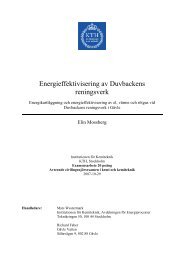Problematik vid höga flöden - Gästrike Vatten AB
Problematik vid höga flöden - Gästrike Vatten AB
Problematik vid höga flöden - Gästrike Vatten AB
Create successful ePaper yourself
Turn your PDF publications into a flip-book with our unique Google optimized e-Paper software.
The results presented in this paper are based on observations in full-scale at the WWTP, and<br />
the experimental work was carried out between the years 2006 to 2009. During this period,<br />
the process has been followed by collecting data from an on-line phosphate analyzer with<br />
continuous samplings of the effluent, as well as laboratory analyses of flow-proportional<br />
samples taken on daily bases in the influent and effluent from the WWTP.<br />
Different tools were used to evaluate the performance of the EBPR-process and to identify<br />
crucial key-factors of significance for the process failure. A hypothesis was adopted based on<br />
recent research, see figure 2. The hypothesis was then used to identify the critical key factors<br />
for the EBPR-process during high-flow conditions. The conclusions from this identification<br />
were finally used to develop different control strategies that were then implemented and<br />
evaluated in full-scale.<br />
To evaluate the EBPR-activity of the activated sludge, anaerobic phosphorus release batch<br />
tests were performed according to Tykesson et al. 2005. The variation of phosphate release<br />
and uptake performance in full scale were monitored by constructing phosphate-profiles along<br />
the anaerobic and aerobic phases which were based on samples taken on a daily basis. The<br />
performance of the primary sludge hydrolysis was followed by taking samples at the outlets<br />
of the primary sedimentation tanks and these were analyzed for phosphate and VFA using a<br />
5-point titration method. The nutrient compounds as well as COD, TOC and VSS were<br />
measured by standard laboratory methods.<br />
Inhibition of primary<br />
sludge hydrolysis<br />
Decreased anaerobic<br />
retention time<br />
Aerobic conditions and<br />
reduced amount of<br />
substrate in the sewer<br />
system<br />
Influence of oxidative<br />
compounds in the<br />
anaerobic reactor<br />
Endogenous starvation<br />
(lack of PHA)<br />
Lack of VFA<br />
Reduced phosphate<br />
release in the<br />
anaerobic reactor<br />
Reduced phosphate<br />
uptake in the aerobic<br />
reactor<br />
High effluent<br />
phosphate loadings<br />
Figure 2. Factors with a possible inhibiting effect on the EBPR process during high-flow conditions.<br />
56<br />
Excessive aeration and<br />
high levels of oxygen<br />
Endogenous starvation<br />
(lack of PHA)<br />
Microbial competition<br />
and changes in bacterial<br />
community structures<br />
Occurrence of<br />
precipitation chemicals<br />
in the activated sludge






